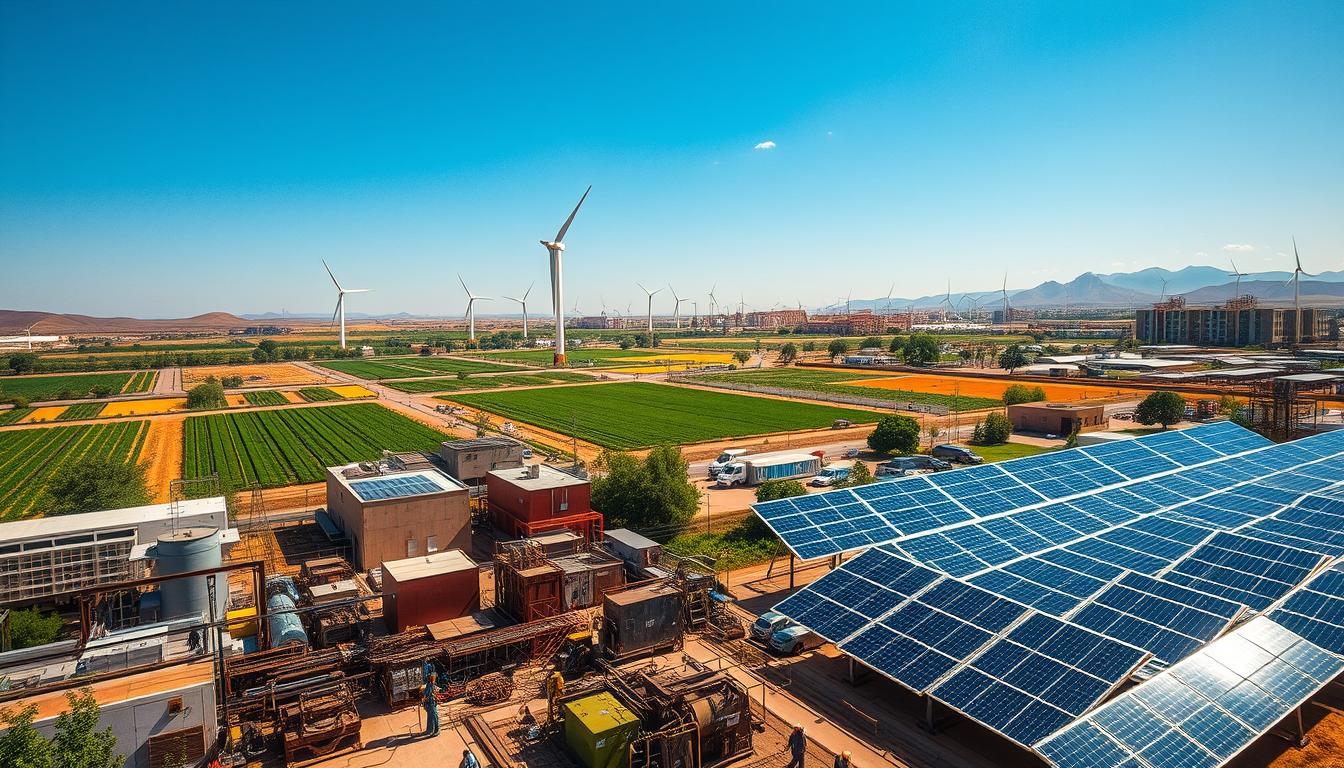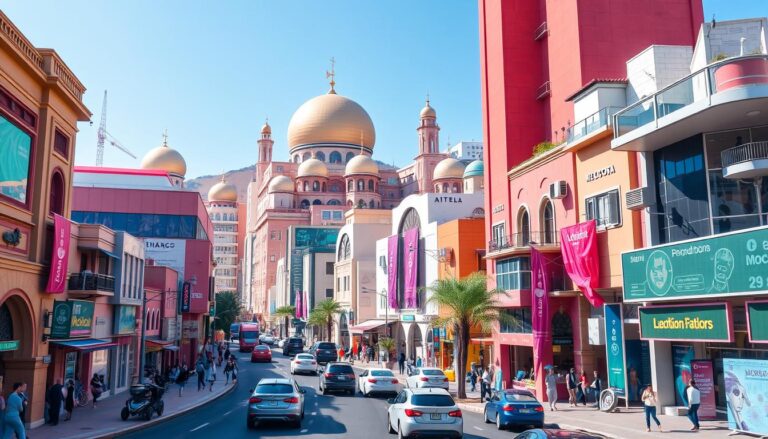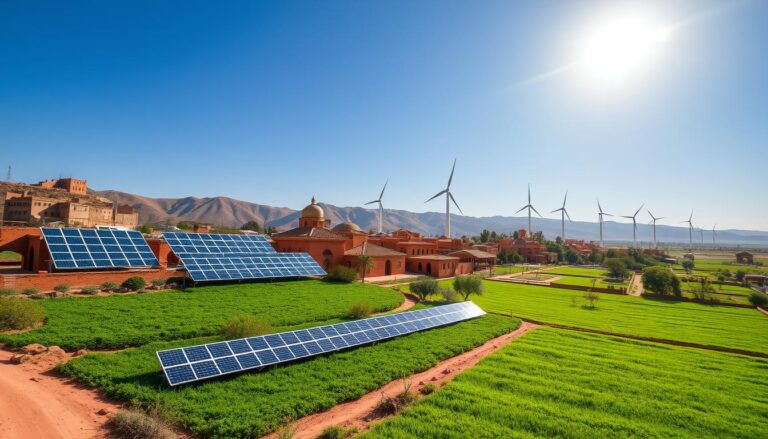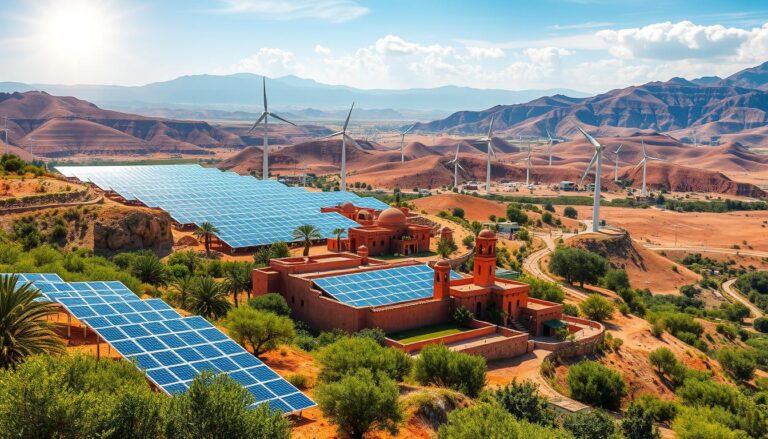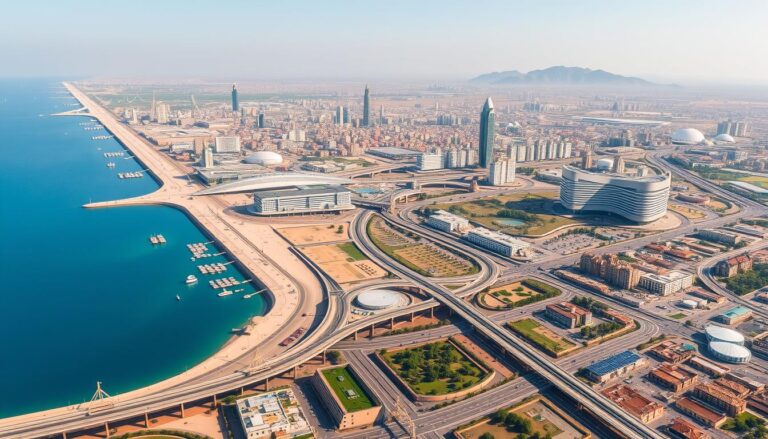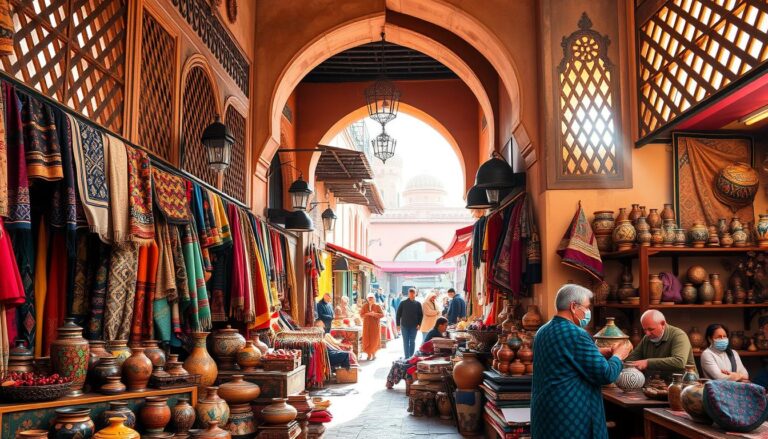What drives a nation to transform from a low-income economy into an emerging industrial powerhouse despite facing numerous adversities?
Since King Mohammed VI took the throne in 1999, Morocco has seen rapid change. Life expectancy has jumped from 66 to 75 years, and income per capita has doubled. The expected years of schooling have also risen, from 8.1 to 14.6 years. This has greatly reduced poverty, from 15.3% in 2001 to just 1.7% by 2019.
Despite challenges like COVID-19, severe droughts, and an earthquake, Morocco has made big strides. The Tanger Med port is a key example of modernization. The country’s highway and railway systems now meet high OECD standards, showing a bright future for growth.
At the heart of Morocco’s success are government initiatives and industrial policies. The Industrial Acceleration Plan 2014-2020 and the National Energy Strategy are key examples. These plans aim to attract more industrial investments and ensure sustainable growth.
Stay tuned as we explore how infrastructure and government plans are driving Morocco’s growth. We’ll see how these efforts are pushing the North African nation towards new heights in industrial development.
Introduction to Morocco’s Industrial Growth
In the early 2000s, Morocco started its industrial reforms to fight off economic shocks. The Morocco Industrial Growth Plans have shown great progress. Morocco’s GDP per capita in 2022 was $3,527.9, as reported by the World Bank.
The country’s economy is expected to grow by 3.1% in 2023. It’s forecasted to grow by 3.7% in 2024 and 4% by 2026.
Morocco’s industrial sector strategy focuses on exports. The Tanger Med port is a key part of this strategy. It connects Morocco to 185 ports and 80 countries.
The port and expanded highways have linked Morocco to global markets. This has brought in a lot of foreign investment. For example, the U.S. had a trade surplus of about $2.02 billion with Morocco in 2022.
The manufacturing growth plan has boosted the automotive and aerospace sectors. Morocco aims to produce 1 million vehicles annually by 2025. U.S. investments have also helped grow the aerospace sector in Casablanca.
The National Energy Strategy is another important plan. It aims for 52% of energy to come from renewables by 2030. This shows Morocco’s commitment to sustainable growth.
These efforts highlight Morocco’s vision for growth and global integration. The Morocco Industrial Growth Plans are driving the country’s economic development.
The Role of Infrastructure in Industrial Growth
Morocco is investing heavily in its industrial sector. The Tanger Med port is a key player in this effort. It’s a modern example of infrastructure that will help Morocco grow.
Tanger Med Port and its Impact
The Tanger Med port opened in 2007 and grew in 2019. It’s now the biggest container port in the Mediterranean. In 2020, it handled 5,771,221 TEU containers, boosting trade and attracting investors.
The port supports Morocco’s growing manufacturing sector. It shows the country’s commitment to developing its industrial infrastructure.
The port’s expansion fits with Morocco’s 2030 National Port Strategy. The plan includes upgrades worth nearly $7.5 billion. Morocco’s 27 commercial ports handled 192.1 million tons in 2021.
Highway and Railway Expansions
Morocco is also focusing on its transportation infrastructure. It plans to expand its highways from 1,800 kilometers to 3,000 kilometers by 2030. This project will cost $9.6 billion.
The country is also launching Africa’s first high-speed rail line. The Tanger-Casablanca line will cost $37 billion. It’s part of Morocco’s 2040 Rail Strategy.
In Casablanca, new tram lines and rapid bus routes are being built. The project will cost $1.6 billion. It aims to connect key economic areas, boosting industrial growth.
In summary, Morocco’s efforts in transportation and port development are key to its industrial growth. These investments are crucial for the country’s future.
Government Initiatives and Policies
The Moroccan government has launched big plans to boost industrial growth and improve its global image. These plans include the Industrial Acceleration Plan 2014–2020 and the National Energy Strategy.
Industrial Acceleration Plan 2014–2020
The Industrial Acceleration Plan 2014–2020 aimed to boost the industrial sector. It attracted a lot of investments. Notably, it brought in big names like Renault and PSA, making Morocco Africa’s top car producer.
This plan also increased foreign direct investment (FDI) in the automotive sector. Morocco saw a 6 percent drop in FDI in 2022 but still got $2.1 billion. France, the UAE, and Spain were the top investors.
The manufacturing sector got 23.6 percent of FDI stocks. This shows the plan’s impact.
National Energy Strategy
The National Energy Strategy works alongside the industrial plan. It focuses on renewable energy, energy efficiency, and regional integration. The goal is to make renewable energy 40 percent of total energy by 2035.
Over $10 billion has been invested in a battery and electric vehicle production chain by 2023. This shows Morocco’s commitment to sustainability and global environmental goals.
Morocco’s mix of economic policies and government initiatives is driving industrial growth. This approach aims for balance and sustainability, making Morocco a strong player globally.
Key Industries Driving Economic Development
Morocco’s economy is changing fast thanks to new sectors. The automotive, aerospace, and renewable energy fields are leading the way. They bring in a lot of foreign money, create jobs, and push tech forward.
Automotive Industry
The automotive industry growth in Morocco is huge. It’s now a top export sector. The goal is to make Morocco a key car-making center.
- A remarkable 44.5% increase in automotive exports in 2017.
- The creation of 83,845 new jobs between 2014 and 2017.
- Local integration in the automotive sector is set to surpass 85% by 2023.
Big names like PSA and Renault are helping Morocco grow in the car world.
Aerospace Industry
More than 60 international companies, including Boeing and Airbus, have set up shop in Morocco. This makes the aerospace sector advancements in Morocco stand out. The good investment climate and location make Morocco a top choice for aerospace.
The aerospace industry in Morocco is impressive:
- Over 60 well-known aerospace companies have set up.
- It attracts top industry leaders.
- It’s a big job creator and boosts high-tech.
Renewable Energy Initiatives
Morocco is going big on renewable energy. The Noor complex is the world’s biggest solar power plant. It shows Morocco’s commitment to green energy. The goal is to get 42% of energy from solar, wind, and hydro by 2020.
This green push also aims to make industries cleaner. It wants to use green hydrogen in many industrial processes. This will help make the future of industry sustainable and eco-friendly.
Investment Opportunities in Morocco
Morocco is a top choice for foreign investors because of its strategic location and stable economy. In 2020 and 2021, it was the ninth most attractive for foreign direct investment (FDI) in Africa. In 2021, FDI jumped by 52 percent to $2.2 billion, with big contributions from France, the UAE, and Spain.
Manufacturing and Industrial Zones
The manufacturing sector in Morocco has seen a lot of investment. Real estate, telecommunications, tourism, and energy also attract a lot of money. The growth of industrial zones is key to this success. Investment opportunities Morocco are plentiful in zones with top-notch infrastructure, aiming to draw more investment and boost industrial growth.
A great example is the MCC’s $131 million investment in industrial parks. It helped set up or improve eleven zones from Tangiers to Agadir. The Bouznika Park Industries extension project, with a $5 million investment, aims to create 4,000 jobs. Morocco is making a great place for investors with its industrial zones.
Public-Private Partnerships
Morocco has seen success through public-private partnerships. For example, three industrial parks were improved to attract more private money. The Green Innov Industry Investment (Gi3) solar water heater plant in Ain Johra is a big success. It aims to make 40,000 solar water heaters by the end of the year, showing Morocco’s dedication to green growth.
The Moroccan government also launched a second call for FONZID projects, adding $15 million to the funding pool. This move aims to attract more private investments. Public-private partnerships Morocco are crucial for reaching big goals in industrial growth. These efforts aim for long-term economic growth, making Morocco a great place for investors.
Morocco as a Global Connector
Morocco is becoming a key player in the global economy. It has developed smart economic plans to boost its international standing. The country has used its location and strong trade deals to grow its role as a global connector.
Trade Agreements and Partnerships
Morocco has made over 50 trade deals with countries like the European Union and the United States. These agreements have helped its economy grow by making it easier to trade goods and services. The EU-Morocco Agreement is especially important, making the EU Morocco’s biggest economic partner.
Morocco is close to Spain, making it a key link between Europe and Africa. The Tanger-Med port is a big deal in Africa and the Mediterranean. It helps with trade, making Morocco a key player in global trade.
Economic Diversification Strategies
The Moroccan government is working hard to make its economy more diverse. It has created special economic zones like the Tanger Free Zone. These zones offer tax breaks and other benefits to attract foreign investors.
Innovation is a big part of Morocco’s plans. The “Morocco Innovation Plan” supports startups and new technologies. The government is investing in education and partnerships to keep the tech sector growing. This is thanks to Morocco’s young, educated, and multilingual people.
In 2017, Morocco drew 10% of all new investments, showing its appeal. Since then, its manufacturing exports have grown by a quarter, beating global trends.
Morocco’s smart moves in trade and diversification make it a key player in the global economy. It’s helping to build strong partnerships for the future.
Challenges and Opportunities Ahead
Morocco has shown great economic strength, but the future is full of challenges. One big issue is finding enough jobs for the growing number of workers. There are also big social and economic gaps to bridge.
Managing resources well is key for lasting success.
There are big hurdles in Morocco’s investment environment. Finding good industrial land is hard, especially for small businesses. They struggle to find places that are both affordable and suitable.
Bringing new ideas into old sectors is also tough. This is because of big challenges in keeping economic and intellectual property reforms moving forward.
But Morocco has many chances for growth. To be more resilient, it needs to diversify its economy. This will help it stay strong even when faced with outside problems.
Improving productivity in all areas is also crucial. Morocco needs to focus on education and training in key fields like engineering, renewable energy, and digital tech. This will help fill the skills gap.
The world is changing fast, and so is Morocco. Its “Digital Morocco 2025” plan is a big step towards becoming more digital. This could really boost the investment environment.
Working together and finding new investment chances in Morocco’s changing economy is exciting.
In the past, Morocco’s economy grew a lot. In 2017, its GDP grew by 4.1% to $109.1bn. Foreign investment also jumped by 34% in 2018 to Dh32.8bn (€3bn).
These numbers show there’s a lot of room for growth. Morocco wants to get 52 percent of its energy from green sources by 2030. This is a big challenge but also a chance for sustainable growth.
The future of Morocco’s economy will depend on how it tackles these challenges and opportunities.
Sustainability and Green Transition
Morocco is leading the way in sustainability with big plans for a green future. Its industrial sector, making up a third of its GDP, is turning to renewable energy. The goal is to cut greenhouse gas emissions by 45.5 percent by 2030.
The Millennium Challenge Corporation (MCC) has given Morocco $131 million for its Employability and Land Compact. This helps the industrial sector grow through partnerships. The MCC also gave Tamwilcom $10 million to start a green loan program, hoping to get up to $160 million in loans.
OCP, Morocco’s big phosphates company, is investing $12 billion in green projects. They aim to be carbon neutral by 2040. This shows Morocco’s commitment to renewable energy and green plans.
But, Moroccan small businesses face high costs for going green. Banks offer loans for green projects, but lack of guarantees is a big problem. So, partnerships between public and private sectors are key to making sustainability work.
Projects like the Noor solar power station show Morocco’s commitment to renewable energy. The National Water Management Plan also shows the kingdom’s focus on sustainability. These plans are crucial for Morocco’s green future.
Morocco also aims to meet EU’s green standards, as 64% of its exports go to Europe. The country has a plan involving 40 industry players. This shows Morocco’s commitment to a green future for all.
Impact of Advanced Regionalization
The advanced regionalization in Morocco is a big step forward. It boosts regional economic growth and political freedom. Moroccan regions now have more power to manage their resources better.
Enhanced Political and Economic Autonomy
Regions in Morocco have gained more political power. They can make policies that fit their needs. This leads to better self-governance and wealth sharing.
With more economic control, regions can support local businesses. They can also attract investments and create jobs. This helps in sustainable economic growth.
Balanced Regional Development
Morocco is investing in areas like the Sahara region. This move gives these regions a chance to use their resources better. It boosts economic activities and infrastructure.
This strategy aims to make the Sahara a major economic and logistics center. It will improve Morocco’s ties with Africa.
The goal of advanced regionalization in Morocco is to narrow the economic gap between men and women. It also aims to improve education and vocational skills. Morocco hopes to grow its economy, use more renewable energy, and boost the digital sector. This will ensure development is balanced and inclusive across the Kingdom.
Conclusion
Morocco has grown a lot in the last 20 years. This growth is thanks to great leaders and strong government plans. The country’s industrial plans have made it a big player in the world economy.
The Tanger Med Port and better transport systems have helped a lot. They have made Morocco’s logistics better and connected it more to the world. Plans like the Industrial Acceleration Plan and the National Energy Strategy show Morocco’s big goals for its economy.
The car and plane making industries, and new energy projects, have helped the economy grow. More foreign money coming in has also helped the country’s GDP. Morocco wants to use more green energy by 2030, showing its commitment to the planet.
These steps have made the economy grow and improved life for people. Life expectancy, income, and education have all gotten better.
Morocco is ready to face new challenges with smart plans. It aims to grow its industry while protecting the environment. Working with private companies and improving trade will help Morocco reach its goals.
In the end, Morocco’s smart plans make it a big player in the world economy. It’s ready to face the challenges of the 21st century.
Source Links
- Developing Morocco’s Industrial Zones to Spur Investment
- Overview
- Morocco’s Economic Growth: Prospects and Government Actions
- Morocco – Market Overview
- Morocco’s Economy & main industries
- Morocco – Infrastructure
- World Bank Document
- Morocco – United States Department of State
- Morocco – United States Department of State
- Economy of Morocco
- Morocco’s Economy Has Become More Resilient
- Economy and Investments of Morocco – Embassy of Morocco in South Africa
- Morocco – Investment Climate Statement
- Investing in Morocco: opportunities & incentives
- Leveraging investment to create sustainable industrial parks in Morocco
- Morocco: The Next Industrial and Technological Hub 🇲🇦🇪🇺🇺🇸🇬🇧
- Morocco ranks among the world’s top trade connector countries
- Morocco: Maximizing Economic Momentum and IP Innovation – SABA IP – Intellectual Property in the Middle East and Africa
- Morocco addressing key challenges to support broader economic growth – Africa 2019 – Oxford Business Group
- Morocco Works to Decarbonize Industrial Parks for a Greener Future
- Morocco: developing an industrial decarbonization roadmap framework | UNIDO
- Just Energy Transitions? Lessons From Oman and Morocco
- No title found
- Country Development Cooperation Strategy (CDCS) – Morocco, 2020-2025
- Morocco’s Long Road Toward Economic Transformation
- Morocco: Beyond Industry – A Path to Sustainable Development 🇲🇦
- No title found

The Editorial Team is a passionate group of Morocco enthusiasts dedicated to sharing the beauty, culture, and wonders of this captivating country. With diverse backgrounds and a deep love for travel, we strive to bring you engaging and informative content that inspires your Moroccan adventures. From uncovering hidden gems and sharing local insights to exploring mouthwatering cuisine and showcasing the vibrant lifestyle, our team is committed to providing you with valuable resources and exciting stories that enhance your exploration of Morocco. Join us on this journey as we celebrate the rich heritage and unforgettable experiences that make Morocco truly special.

